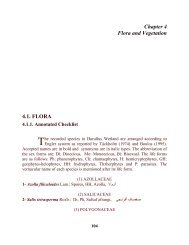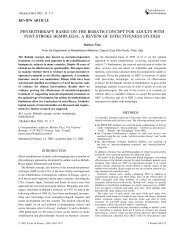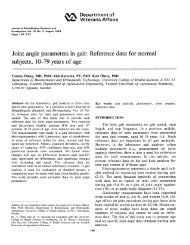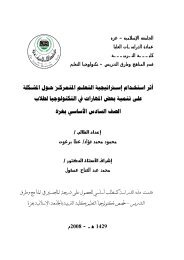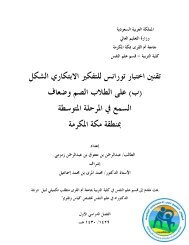Appendix OneHis<strong>to</strong>rical Survey of Mental RetardationIn reviewing <strong>the</strong> literature in <strong>the</strong> field of mental retardation, one becomes aware of <strong>the</strong>valuable contributions made in <strong>the</strong> field by such pioneers as Jean Marc Itard, Edward Seguin, andMarie Montessori. The work of <strong>the</strong>se pioneers and <strong>the</strong>ir disciples during <strong>the</strong> nineteenth centurymay well be viewed as <strong>the</strong> first golden age for <strong>the</strong> mentally retarded pupil. 1Much progress has been made since <strong>the</strong> time when all mentally retarded children werebelieved <strong>to</strong> be possessed by demons which could only be expelled by magic and prayer. In ancienttimes <strong>the</strong> lot of <strong>the</strong> retarded was hopeless, <strong>the</strong> Spartans simply let <strong>the</strong>m die of exposure. Theearliest known patron, <strong>the</strong> fourth-century prelate, <strong>the</strong> Bishop of Myra, has been described asprotec<strong>to</strong>r of <strong>the</strong> feebleminded; however, be is patron saint of all children and not qualified <strong>to</strong>figure in <strong>the</strong> chronicles of mental retardation. 2The rise of Christianity marked a gradual change in attitude. During <strong>the</strong> Christian era, <strong>the</strong>retarded were sheltered and treated much more humanely. The nineteenth century saw <strong>the</strong>problem of care and training of retarded individuals solved in a more scientific manner with suchleaders as Itard, Seguin, Montessori and Decroly pioneering in what is now termed "specialeducation."Jean Marc Itard, a French philosopher (1774-1838), used methods of experimentalpsychology in attempting <strong>to</strong> teach or enculturate a retarded child. 3 He was inspired by <strong>the</strong>philosophy of sensationalism and <strong>the</strong> French post-revolutionary belief that man had unlimitedpossibilities, and that education and environment were fac<strong>to</strong>rs in mental development. 4In 1799 a boy about twelve years of age was captured in <strong>the</strong> forest of Aveyron in sou<strong>the</strong>rnFrance. This boy, whom <strong>the</strong>y called Vic<strong>to</strong>r, resembled a wild animal more than a human being.He was unable <strong>to</strong> speak, he selected his food by smell, attempted <strong>to</strong> escape, and in general did notrespond like a human being. Reacting as an animal, be was consequently called "The Wild Boy ofAveyron." Itard felt that this boy was a good example of a completely untu<strong>to</strong>red human being,and that with proper educational procedures applied <strong>to</strong> <strong>the</strong> training of <strong>the</strong> senses, this untu<strong>to</strong>redboy could be made human. 5He embodied his program in<strong>to</strong> five propositions:1. To endear him <strong>to</strong> social life, by making it more congenial than <strong>the</strong> one he was nowleading.2. To awaken his nervous sensibility, by <strong>the</strong> most energetic stimulations; and at o<strong>the</strong>r timesby quickening <strong>the</strong> affections of <strong>the</strong> soul.3. To extend <strong>the</strong> sphere of his ideas, by creating new wants, and multiplying his associationswith surrounding beings.4. To lead him <strong>to</strong> <strong>the</strong> use of speech, by determining <strong>the</strong> exercise of imitation, under <strong>the</strong> spurof necessity.5. To exercise <strong>the</strong> simple operations of his mind upon his physical wants, and <strong>the</strong>refromderive <strong>the</strong> application of <strong>the</strong> same <strong>to</strong> objects of instruction. 6In 1802 he framed ano<strong>the</strong>r program, more fitted for an idiot than a savage, whose foundationwas physiological and whose generality embraced: (1) <strong>the</strong> development of <strong>the</strong> senses, (2) <strong>the</strong>development of <strong>the</strong> intellectual facilities, and (3) <strong>the</strong> development of <strong>the</strong> affective functions. 7
Itard was successful in getting <strong>the</strong> boy <strong>to</strong> control his actions and read a few words byemploying <strong>the</strong> basic rule of learning since posited by such learning <strong>the</strong>orists as Thorndike andHull: "repeated rewarding trials." While Itard felt that his experiment was a failure, educa<strong>to</strong>rsneed <strong>to</strong> closely observe his teaching procedures. His goals were <strong>to</strong> develop in Vic<strong>to</strong>rsocialization, mental training through sensory stimulation, and speech, creating human wants anddesires and intelligence. 8 By present standards, <strong>the</strong>se are also recognized as important goals in <strong>the</strong>teaching of mentally retarded children. Itard's work shows <strong>the</strong> effectiveness of a system ofmotivation and rewards, <strong>the</strong> importance of individualized instruction, and of systematicprogramming of learning experiences. 9Seguin (1812-1880), heir <strong>to</strong> Itard's observations and experiences, physician, neurologist, andeduca<strong>to</strong>r, continued <strong>the</strong> search for training procedures for mental retardation. Instead of workingwith a single boy like Vic<strong>to</strong>r, be established <strong>the</strong> first public residential facility in France formentally retarded and devised a curriculum for <strong>the</strong>m. 10 His was a "neurophysiological techniquebased upon <strong>the</strong> belief that <strong>the</strong> impaired nervous systems of retarded could be reeducated by mo<strong>to</strong>rand sensory training." 11 In 1846 be published a book outlining <strong>the</strong> treatment and education ofidiots. 12 In his second book, he outlined a residential school program which could be utilized<strong>to</strong>day. 13Seguin's philosophy of education is not <strong>to</strong>o different from many of <strong>the</strong> principles advocated<strong>to</strong>day. He emphasized <strong>the</strong> education of <strong>the</strong> whole child, <strong>the</strong> individualization of instruction, <strong>the</strong>primary importance of rapport between <strong>the</strong> teacher and <strong>the</strong> pupil, <strong>the</strong> physical comfort of <strong>the</strong> childduring <strong>the</strong> learning period, and <strong>the</strong> importance of beginning with <strong>the</strong> needs of <strong>the</strong> child, his wantsand desires, before progressing in<strong>to</strong> <strong>the</strong> area of <strong>the</strong> unknown. 14Seguin has made a challenging contribution <strong>to</strong> <strong>the</strong> area of mental retardation, and <strong>the</strong> reader isreferred <strong>to</strong> o<strong>the</strong>r of his works for a more extensive research on his relationship <strong>to</strong> this area ofinterest. 15However, Seguin was not successful in res<strong>to</strong>ring severely retarded children <strong>to</strong> normalfunctioning, and <strong>the</strong> early hopes of society for <strong>the</strong> residential-school soon faded. At <strong>the</strong> end of <strong>the</strong>nineteenth century, a wave of pessimism swept <strong>the</strong> country. No longer were residential schoolsviewed as training institutions for <strong>the</strong> habilitation of <strong>the</strong> mentally retarded. Instead, <strong>the</strong>y wereviewed as cus<strong>to</strong>dial facilities for children and adults who were hopelessly dependent. Only in <strong>the</strong>last decade or so has <strong>the</strong>re been a strong resurgence in training. 16Marie Montessori (1870-1956) elaborated still fur<strong>the</strong>r upon <strong>the</strong> Itard and Seguin proceduresin developing a training program for <strong>the</strong> mentally retarded in <strong>the</strong> residential facilities of Rome.Her techniques for <strong>the</strong> retarded were given less of a trial in <strong>the</strong> United States than in somecountries of Europe and Asia because of <strong>the</strong> pessimism following Seguin's efforts.She stressed ten rules of education which she considered equally appropriate for preschoolnormal and school-age trainable children. These ten rules are:1. Children are different from adults and need <strong>to</strong> be approached differently,2. Learning comes from within and is spontaneous.3. Children need a childhood environment which stresses free play, games, and colorfulmaterials.4. Children love order.5. Children must have freedom of choice.6. Children love silence.7. Children prefer work <strong>to</strong> play.
- Page 2 and 3:
CONTENTSCHAPTERIntroductionPart I F
- Page 4 and 5:
since three hundred mentally retard
- Page 6 and 7:
probably learn those things which p
- Page 8 and 9:
age forty, her chances of producing
- Page 10 and 11:
Professionals are fond of telling t
- Page 12 and 13:
An accurate definition of the "trai
- Page 14 and 15:
Teachers can use visual materials t
- Page 16 and 17:
6. Positive reinforcement should be
- Page 18 and 19:
ealize just how desperately these c
- Page 20 and 21:
However, Ms teacher must deal with
- Page 22 and 23: he can perform well. A single perfo
- Page 24 and 25: pupils. Teachers must be careful to
- Page 26 and 27: in teaching trainable mentally reta
- Page 28 and 29: 9. The picture-and-question combina
- Page 30 and 31: are able to conceptualize. The auth
- Page 32 and 33: PART IISuccessful MinistryChapter 5
- Page 34 and 35: their children's handicap." He ment
- Page 36 and 37: has never been disciplined not to b
- Page 38 and 39: BUILDINGS AND EQUIPMENTThe well-pla
- Page 40 and 41: 6Who Shall Teach theMentally Retard
- Page 42 and 43: Those in special education become a
- Page 44 and 45: the media or method through which h
- Page 46 and 47: The teacher divests his pupil of ye
- Page 48 and 49: Can I set limits, then relax and al
- Page 50 and 51: etter lead the person in learning e
- Page 52 and 53: a way that His redeeming love is ev
- Page 54 and 55: The retarded have a low level of co
- Page 56 and 57: Most mentally retarded persons enjo
- Page 58 and 59: 8How Shall the Family Be CounseledR
- Page 60 and 61: place, attempting abortion, permiss
- Page 62 and 63: school with a neighboring family, b
- Page 64 and 65: Some will make an adequate adjustme
- Page 66 and 67: church family "has been no problem
- Page 68 and 69: criticize his every deed. Randy is
- Page 70 and 71: If there is any starting point with
- Page 74 and 75: 8. Children love repetition.9. Chil
- Page 76 and 77: general intellectual functioning, (
- Page 78 and 79: SOURCE: J. V. Hottel, The Tennessee
- Page 80 and 81: 8. Ibid., p. 56.9. Ibid., p. 57.10.
- Page 82 and 83: 17. Ibid., pp. 18-22.18. Louis Rose
- Page 84 and 85: 24. Ovid. Decroly, La Classificatio
- Page 86 and 87: Cruiksbank, William M. et al. A Tea
- Page 88 and 89: Koenig, Frances. "Implications in t
- Page 90: UNESCO. Organization of Special Edu


![Successful Ministry to the Retarded[ETowns] - Elmer Towns](https://img.yumpu.com/47721906/72/500x640/successful-ministry-to-the-retardedetowns-elmer-towns.jpg)




